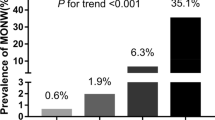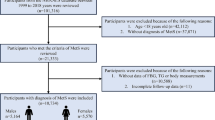Abstract
Background
There is no established parameter with which to screen metabolically obese phenotypes.
Aim
The aim of the study was to revise the upper limit of normal (ULN) of serum alanine aminotransferase (ALT) and to investigate the predictive value of updated ALT levels for metabolic obese phenotype stratified according to body mass index (BMI).
Methods
We analyzed a nationally representative data from the Fourth Korea National Health and Nutrition Examination Survey. This cross-sectional study included 2,416 healthy people aged 33.9 ± 0.3 years. The ULN of healthy ALT level was set at the 95th percentile of the healthy population. A metabolic obese phenotype was defined as having insulin resistance or metabolic syndrome. A logistic regression analysis was performed to assess the odds ratio for a metabolic obese phenotype according to the healthy ALT level.
Results
The revised ULN of serum ALT level in healthy participants were 30 IU/L and 22 IU/L for males and females, respectively. Serum ALT level was higher in individuals with metabolic obesity compared with those without metabolic obesity in both genders, stratified according to BMI. After adjusting for age, BMI, smoking, alcohol drinking, and regular physical activity, unhealthy normal ALT levels (males 30–40 IU/L, females 22–40 IU/L) were significantly associated with metabolic obesity, especially in both obese and non-obese women.
Conclusions
A newly revised threshold for ALT is proposed as a simple clinical metabolic parameter that can identify a metabolic obese phenotype. We suggest that people with unhealthy normal ALT levels may need further investigation for the presence of metabolic obesity.

Similar content being viewed by others
References
DeFronzo RA, Ferrannini E. Insulin resistance. A multifaceted syndrome responsible for NIDDM, obesity, hypertension, dyslipidemia, and atherosclerotic cardiovascular disease. Diabetes Care. 1991;14:173–194.
Naser KA, Gruber A, Thomson GA. The emerging pandemic of obesity and diabetes: are we doing enough to prevent a disaster? Int J Clin Pract. 2006;60:1093–1097.
Aguilar-Salinas CA, Garcia EG, Robles L, et al. High adiponectin concentrations are associated with the metabolically healthy obese phenotype. J Clin Endocrinol Metab. 2008;93:4075–4079.
Stefan N, Kantartzis K, Machann J, et al. Identification and characterization of metabolically benign obesity in humans. Arch Intern Med. 2008;168:1609–1616.
Ruderman N, Chisholm D, Pi-Sunyer X, et al. The metabolically obese, normal-weight individual revisited. Diabetes. 1998;47:699–713.
Gaillard TR, Schuster D, Osei K. Characterization of metabolically unhealthy overweight/obese African American women: significance of insulin-sensitive and insulin-resistant phenotypes. J Natl Med Assoc. 2012;104:164–171.
Lee SH, Ha HS, Park YJ, et al. Identifying metabolically obese but normal-weight (MONW) individuals in a nondiabetic Korean population: the Chungju Metabolic disease Cohort (CMC) study. Clin Endocrinol (Oxf). 2011;75:475–481.
Bastard JP, Maachi M, Lagathu C, et al. Recent advances in the relationship between obesity, inflammation, and insulin resistance. Eur Cytokine Netw. 2006;17:4–12.
Kim HC, Choi KS, Jang YH, et al. Normal serum aminotransferase levels and the metabolic syndrome: Korean National Health and Nutrition Examination Surveys. Yonsei Med J. 2006;47:542–550.
Fraser A, Longnecker MP, Lawlor DA. Prevalence of elevated alanine aminotransferase among US adolescents and associated factors: NHANES 1999–2004. Gastroenterology. 2007;133:1814–1820.
Suh SY, Choi SE, Ahn HY, et al. The association between normal alanine aminotransferase levels and the metabolic syndrome: 2005 Korean National Health and Nutrition Examination Survey. Metabolism. 2009;58:1731–1736.
Pratt DS, Kaplan MM. Evaluation of abnormal liver-enzyme results in asymptomatic patients. N Engl J Med. 2000;342:1266–1271.
Messier V, Karelis AD, Robillard ME, et al. Metabolically healthy but obese individuals: relationship with hepatic enzymes. Metabolism. 2010;59:20–24.
Prati D, Taioli E, Zanella A, et al. Updated definitions of healthy ranges for serum alanine aminotransferase levels. Ann Intern Med. 2002;137:1–10.
Lee JK, Shim JH, Lee HC, et al. Estimation of the healthy upper limits for serum alanine aminotransferase in Asian populations with normal liver histology. Hepatology. 2010;51:1577–1583.
Kang HS, Um SH, Seo YS, et al. Healthy range for serum ALT and the clinical significance of “unhealthy” normal ALT levels in the Korean population. J Gastroenterol Hepatol. 2011;26:292–299.
Kim HA, Lee SY, Kwon HS, et al. Gender differences in the association of insulin resistance with metabolic risk factors among Korean adolescents: Korea National Health and Nutrition Examination Survey 2008–2010. Diabetes Res Clin Pract. 2013;99:54–62.
Choi YJ, Lee MS, An SY, et al. The relationship between diabetes mellitus and health-related quality of life in Korean adults: The Fourth Korea National Health and Nutrition Examination Survey (2007–2009). Diabetes Metab J. 2011;35:587–594.
Expert Committee on the Diagnosis and Classification of Diabetes Mellitus (2003) Report of the expert committee on the diagnosis and classification of diabetes mellitus. Diabetes Care. 2003;26:S5–S20.
Kim CH, Park HS, Park M, et al. Optimal cutoffs of percentage body fat for predicting obesity-related cardiovascular disease risk factors in Korean adults. Am J Clin Nutr. 2011;94:34–39.
WHO (2000) The Asia–Pacific perspective: redefining obesity and its treatment. World Health Organization, Geneva.
Alberti KG, Eckel RH, Grundy SM, et al. Harmonizing the metabolic syndrome: a joint interim statement of the International Diabetes Federation Task Force on Epidemiology and Prevention; National Heart, Lung, and Blood Institute; American Heart Association; World Heart Federation; International Atherosclerosis Society; and International Association for the Study of Obesity. Circulation. 2009;120:1640–1645.
Matthews DR, Hosker JP, Rudenski AS, et al. Homeostasis model assessment: insulin resistance and beta-cell function from fasting plasma glucose and insulin concentrations in man. Diabetologia. 1985;28:412–419.
Balkau B, Charles MA. Comment on the provisional report from the WHO consultation. European Group for the Study of Insulin Resistance (EGIR). Diabet Med. 1999;16:442–443.
Elinav E, Ben-Dov IZ, Ackerman E, et al. Correlation between serum alanine aminotransferase activity and age: an inverted U curve pattern. Am J Gastroenterol. 2005;100:2201–2204.
Siest G, Schiele F, Galteau MM, et al. Aspartate aminotransferase and alanine aminotransferase activities in plasma: statistical distributions, individual variations, and reference values. Clin Chem. 1975;21:1077–1087.
Marchesini G, Avagnina S, Barantani EG, et al. Aminotransferase and gamma-glutamyltranspeptidase levels in obesity are associated with insulin resistance and the metabolic syndrome. J Endocrinol Invest. 2005;28:333–339.
Kim CH, Younossi ZM. Nonalcoholic fatty liver disease: a manifestation of the metabolic syndrome. Cleve Clin J Med. 2008;75:721–728.
Petersen KF, Dufour S, Befroy D, et al. Reversal of nonalcoholic hepatic steatosis, hepatic insulin resistance, and hyperglycemia by moderate weight reduction in patients with type 2 diabetes. Diabetes. 2005;54:603–608.
Park JH, Kim SH, Park S, et al. Alanine aminotransferase and metabolic syndrome in adolescents: the Korean National Health and Nutrition Examination Survey Study. Pediatr Obes. doi:10.1111/j.2047-6310.2013.00199.x.
Cerda C, Perez-Ayuso RM, Riquelme A, et al. Nonalcoholic fatty liver disease in women with polycystic ovary syndrome. J Hepatol. 2007;47:412–417.
Volzke H, Schwarz S, Baumeister SE, et al. Menopausal status and hepatic steatosis in a general female population. Gut. 2007;56:594–595.
Kaplan MM. Alanine aminotransferase levels: what’s normal? Ann Intern Med. 2002;137:49–51.
Green RM, Flamm S. AGA technical review on the evaluation of liver chemistry tests. Gastroenterology. 2002;123:1367–1384.
Stedman C. Herbal hepatotoxicity. Semin Liver Dis. 2002;22:195–206.
Dimitrijevic-Sreckovic V, Soldatovic I, Culafic D, et al. Liver function test changes in centrally obese youth with metabolic syndrome in a Serbian population. Metab Syndr Relat Disord. 2013;11:427–433.
Deboer MD, Wiener RC, Barnes BH, et al. Ethnic differences in the link between insulin resistance and elevated ALT. Pediatrics. 2013;132:e718–e726.
Acknowledgments
This research was supported by a grant of the Korean Healthcare Technology R&D Project, Ministry for Health and Welfare, Republic of Korea (Grant Number A102065). No other support, writing assistance, data analysis support were provided.
Conflict of interest
None.
Author information
Authors and Affiliations
Corresponding author
Additional information
Hee Yeon Kim and Chang Wook Kim have equally contributed to this article.
Electronic supplementary material
Below is the link to the electronic supplementary material.
Rights and permissions
About this article
Cite this article
Kim, H.Y., Kim, C.W., Lee, C.D. et al. Can “Healthy” Normal Alanine Aminotransferase Levels Identify the Metabolically Obese Phenotype? Findings from The Korea National Health and Nutrition Examination Survey 2008–2010. Dig Dis Sci 59, 1330–1337 (2014). https://doi.org/10.1007/s10620-013-2995-0
Received:
Accepted:
Published:
Issue Date:
DOI: https://doi.org/10.1007/s10620-013-2995-0




